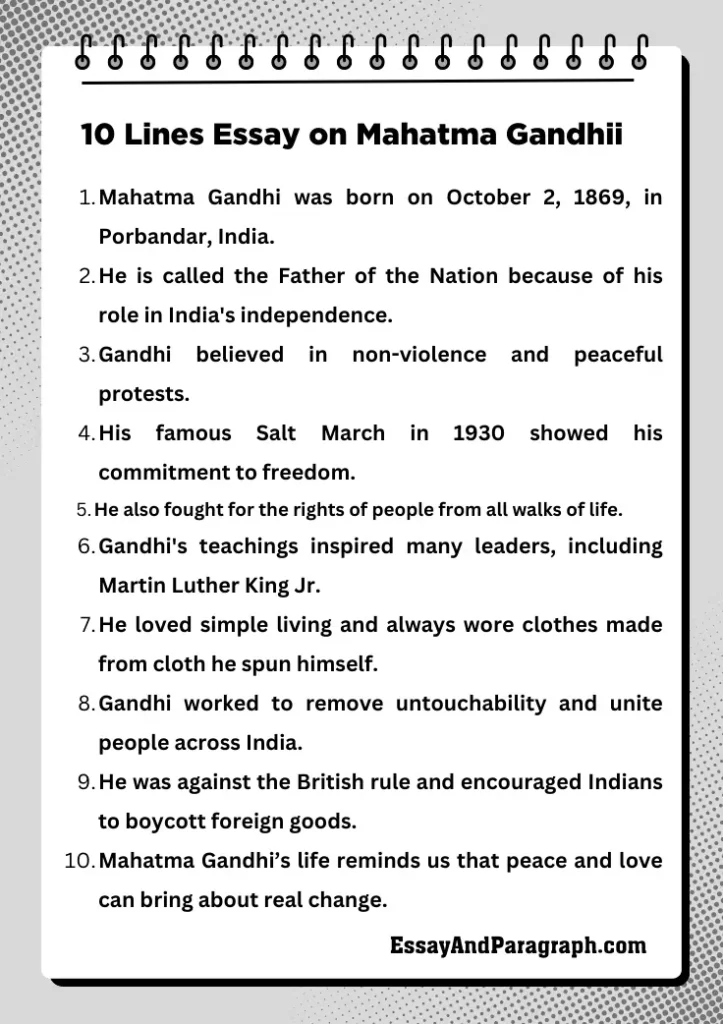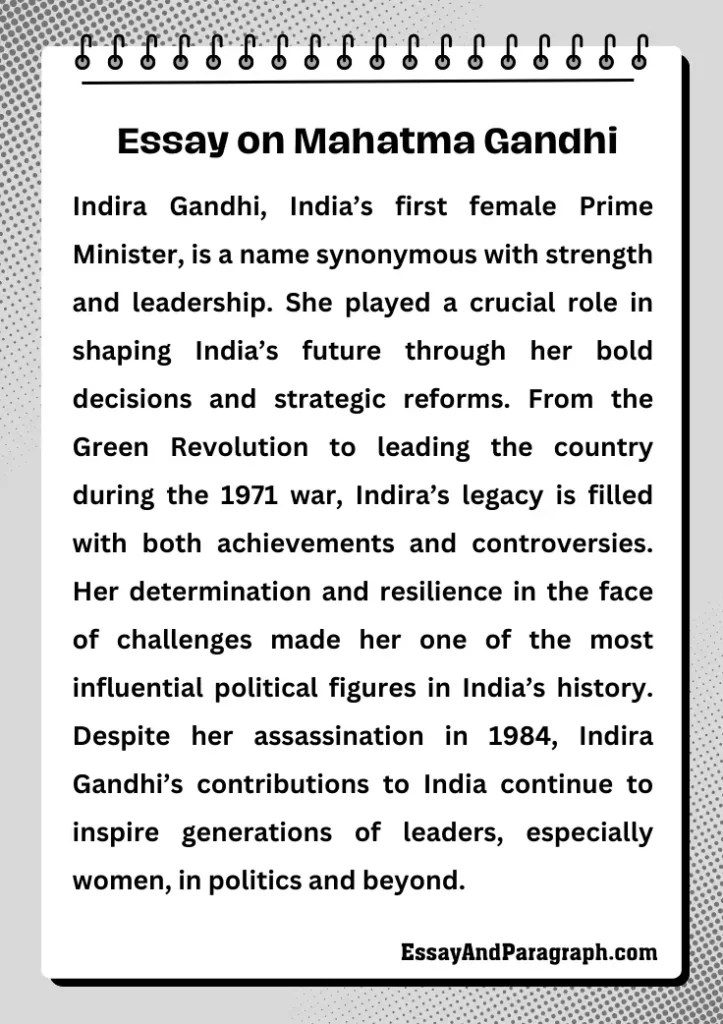Have you ever wondered who shaped India’s path to freedom with love and non-violence? The answer is Mahatma Gandhi, also known as the “Father of the Nation.” He was a simple man with a big heart and a powerful mind who fought for India’s independence without violence, proving that peace can conquer even the greatest challenges. In this article, we will learn how to write an essay on Mahatma Gandhi, covering his life, achievements, and the lessons we can still learn from him.
10 Lines Essay on Mahatma Gandhi in English
Mahatma Gandhi was born on October 2, 1869, in Porbandar, India.
He is called the Father of the Nation because of his role in India’s independence.
Gandhi believed in non-violence and peaceful protests.
His famous Salt March in 1930 showed his commitment to freedom.
He also fought for the rights of people from all walks of life.
Gandhi’s teachings inspired many leaders, including Martin Luther King Jr.
He loved simple living and always wore clothes made from cloth he spun himself.
Gandhi worked to remove untouchability and unite people across India.
He was against the British rule and encouraged Indians to boycott foreign goods.
Mahatma Gandhi’s life reminds us that peace and love can bring about real change.

Short Essay on Mahatma Gandhi
Mahatma Gandhi, born in 1869 in Porbandar, India, became the leader of the Indian independence movement. He is best known for his philosophy of non-violence, which became a powerful tool in fighting British colonial rule. Gandhi’s belief in peaceful protests was revolutionary, and he led several movements like the Salt March and Quit India Movement to unite Indians in their struggle for freedom.
Gandhi’s personal life reflected his principles. He lived simply, wearing clothes made from khadi (homespun cotton) to support Indian industries. He also fought for the rights of all Indians, including those who were marginalized by society, especially the untouchables. Through his actions, Gandhi showed that non-violence and truth could bring change without the need for violence.
His impact wasn’t limited to India. His teachings of peaceful resistance inspired many civil rights leaders around the world, including Martin Luther King Jr. and Nelson Mandela. Gandhi’s belief in peace and harmony continues to inspire millions of people globally.
Although his life ended tragically when he was assassinated in 1948, his legacy still lives on in the form of his principles and the India he helped shape. He proved that even a single person, with conviction and dedication, could change the course of history.
Long Essay on Mahatma Gandhi
Mahatma Gandhi, born on October 2, 1869, in Porbandar, India, became the iconic leader who led India to independence from British rule. Gandhi’s journey to becoming a global symbol of peace and non-violence was not an easy one. After studying law in London and working in South Africa, Gandhi returned to India in 1915 and began advocating for social and political reforms. His methods were unique — he encouraged peaceful protests, civil disobedience, and non-cooperation with the British authorities.
One of Gandhi’s most famous acts of defiance was the Salt March of 1930. At the time, the British imposed a salt tax on Indians, and Gandhi decided to break this unjust law by marching 240 miles to the sea to produce salt. This act of civil disobedience attracted worldwide attention and symbolized the power of non-violence. It was a turning point in the Indian independence movement, as it united people from all regions and backgrounds against British rule.
Gandhi was also a champion of social justice, working tirelessly to end the practice of untouchability and improve the lives of the marginalized sections of society. He coined the term “Harijan” to refer to untouchables, meaning “children of God,” and advocated for their inclusion in mainstream society.
Throughout his life, Gandhi remained committed to his philosophy of Ahimsa, or non-violence, and Satyagraha, or truth-force. These principles guided him in all his struggles, whether in the fight for India’s freedom or in his quest for social equality. Gandhi believed that true power came not from violence but from the moral strength to stand by what is right.
However, Gandhi’s path was not without challenges. His non-violent approach often led to criticism from other political leaders, who believed that a more aggressive stance was needed. Yet, Gandhi remained resolute, teaching the world that peace, patience, and love could achieve more than hatred and violence ever could.
Gandhi’s influence spread far beyond India. His philosophy inspired many global leaders in their own struggles for justice and freedom. One of his most famous admirers was Dr. Martin Luther King Jr., who adopted Gandhi’s techniques of non-violent resistance during the American Civil Rights Movement. Gandhi’s teachings continue to resonate today, reminding us of the power of peace and compassion.
Sadly, Mahatma Gandhi’s life was cut short when he was assassinated on January 30, 1948. However, his legacy lives on in the form of the India he helped shape and the principles of non-violence and truth that continue to inspire millions worldwide. Gandhi remains a symbol of peace and an enduring figure in the history of the world.
FAQs
1. Who was Mahatma Gandhi?
Mahatma Gandhi, born in 1869 in India, was the leader of the Indian independence movement. He is best known for his philosophy of non-violence and peaceful protests. Gandhi led India’s struggle against British rule and played a key role in achieving independence in 1947.
2. What were Mahatma Gandhi’s main contributions to India?
Gandhi’s main contributions include his leadership in the Indian independence movement through non-violent means. He led the Salt March, Quit India Movement, and worked to abolish untouchability and promote social equality. His efforts resulted in India gaining independence from British rule in 1947.
3. Why is Mahatma Gandhi called the Father of the Nation?
Mahatma Gandhi is called the Father of the Nation because of his pivotal role in India’s independence movement. His leadership and philosophy of non-violence brought millions together to fight against British colonial rule, ultimately leading to India’s independence.
4. How did Gandhi impact the world?
Gandhi’s philosophy of non-violence and peaceful resistance influenced many global leaders, including Martin Luther King Jr. and Nelson Mandela. His teachings on civil rights and social justice continue to inspire movements for peace and equality worldwide.
5. What is the significance of the Salt March?
The Salt March of 1930 was a pivotal moment in the Indian independence movement. Gandhi led a 240-mile march to the sea to protest the British salt tax. This peaceful act of civil disobedience united Indians from all walks of life and garnered international attention to the independence cause.
6. What did Gandhi do to fight untouchability?
Gandhi fought against untouchability by promoting the inclusion of the so-called “untouchables” in society. He called them “Harijans” or “children of God” and worked to remove social barriers, encourage education for all, and ensure their rights were recognized.
Top 5 Quotes on Mahatma Gandhi
“Be the change that you wish to see in the world.”
“An eye for an eye only ends up making the whole world blind.”
“The best way to find yourself is to lose yourself in the service of others.”
“In a gentle way, you can shake the world.”
“Live as if you were to die tomorrow. Learn as if you were to live forever.”
Summary
Mahatma Gandhi was more than just a leader of India’s independence movement. His philosophy of non-violence, truth, and peaceful resistance not only helped free India from British rule but also inspired global movements for justice and equality. Gandhi’s life was a testament to the power of patience, humility, and love in achieving meaningful change. His teachings continue to resonate, reminding us that peace can overcome even the greatest challenges.




